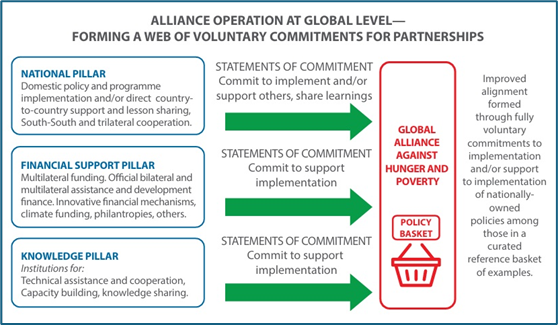Why in news?
The Global Alliance Against Hunger and Poverty was officially launched during the G20 Leaders’ Summit in Rio de Janeiro, Brazil. Its primary objective is to accelerate efforts toward the eradication of hunger and poverty globally while promoting the achievement of the Sustainable Development Goals (SDGs).
What’s in today’s article?
- Hunger and India
- Global Alliance Against Hunger and Poverty
Hunger and India
- What is Hunger?
- The Food and Agriculture Organization (FAO) defines hunger as food deprivation, or undernourishment, as the habitual consumption of too few calories to provide the minimum dietary energy an individual requires to live a healthy and productive life, given that person’s sex, age, stature, and physical activity level.
- Hunger and India
- India is ranked 105th among 127 countries in the Global Hunger Index (GHI) 2024, indicating a ‘serious’ level of hunger.
- Notably, India’s GHI score of 27.3 is a cause for concern, especially when compared to its South Asian neighbours like Bangladesh, Nepal, and Sri Lanka, which fall into the “moderate” category.
Global Alliance Against Hunger and Poverty
- The Need for the Alliance
- The 2030 Agenda for Sustainable Development, adopted in 2015 by all UN Member States, set targets to end poverty, hunger, and ensure food security by 2030.
- However, the Covid-19 pandemic reversed progress, leading to a rise in extreme poverty and declining nutrition standards, particularly in the Global South.
- Projections indicate 622 million people will live below the extreme poverty line of $2.15 per day by 2030.
- 582 million people are expected to live in hunger by 2030, the same as in 2015.
- Global conflicts, climate change, and inequalities have further weakened progress.
- About
- The G20 summit in Rio de Janeiro launched the Global Alliance Against Hunger and Poverty, connecting nations with resources to tackle hunger.
- Led by Brazil’s President Luiz Inácio Lula da Silva, the initiative focuses on cash transfers, school meals, and support for farmers.
- Aims/objectives
- The alliance aims to eradicate hunger and poverty by 2030, aligning with the Sustainable Development Goals (SDGs).
- Its key objective is to remove all nations from the FAO Hunger Map by fostering collaboration and resource mobilization.
- Membership and Structure
- Members: 148, including 82 countries; African Union and European Union; 24 international organizations; 9 financial institutions; 31 philanthropic and non-governmental organizations.
- Available to non-G20 countries since July 2024.
- Early members include Brazil, Bangladesh, and G20 members, with participants spanning all continents.
- Key Pillars of the Alliance
- National: Coordination of public policies specific to eradicating hunger.
- Knowledge: Integration of data and technologies for evidence-based solutions.
- Financial: Large-scale resource mobilization to fund programs.

- Strategic Commitments
- Income Distribution: Reach 500 million people through income support programs by 2030.
- School Meals: Provide school meals to 150 million children in high-hunger regions.
- Financial Mobilization: Leverage multilateral banks to raise billions for anti-poverty initiatives.
- Funding
- No exclusive fund; relies on contributions from members and institutions like FAO, UNICEF, and the World Bank.
- Estimated operational cost: $2-3 million annually.
- Technical Office
- Based at FAO with functional autonomy.
- It is expected that the headquarters of this alliance will be based in Brasilia or another Global South country.
- Key Activities
- Regular Summits Against Hunger and Poverty.
- Creation of a High-Level Champions Council to oversee alliance activities.
- Other features
- Facilitates sharing of best practices among members.
- Provides technical expertise or financial support for national hunger and poverty eradication policies.
- Includes a policy basket with over 50 instruments for targeted support in areas like: School meals; Cash transfers; Support for smallholder and family farming; Socio-economic inclusion programs; Maternal and early childhood interventions; Water access solutions.
- The Alliance acts as a matchmaking platform, connecting countries in need with donors and support organizations.










